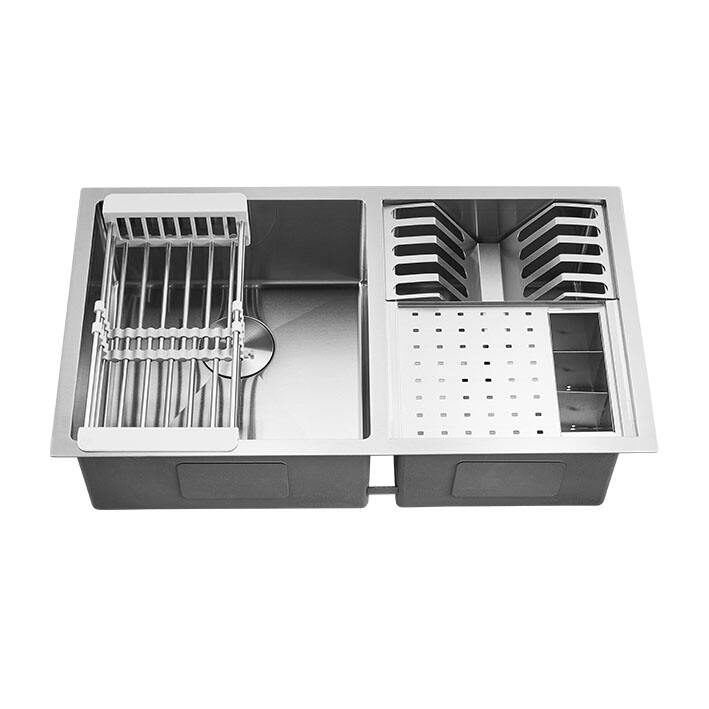Essential Guidelines for Choosing Your Perfect 304 Kitchen Sink
The heart of every kitchen lies in its functionality, and at the center of this functionality stands the kitchen sink. When it comes to selecting a 304 kitchen sink, the decision process involves much more than just picking an attractive design. This premium-grade stainless steel option has become increasingly popular among homeowners and designers alike, offering an optimal balance of durability, aesthetics, and practical features. Understanding the key aspects that make a 304 kitchen sink worth your investment will ensure you make an informed decision that serves your needs for years to come.
Understanding 304 Stainless Steel Quality
Composition and Durability Features
A 304 kitchen sink represents the gold standard in stainless steel construction. This grade contains approximately 18% chromium and 8% nickel, creating a robust material that resists corrosion and maintains its luster even after years of daily use. The high chromium content forms an invisible protective layer that continuously regenerates when exposed to oxygen, making these sinks particularly resistant to scratches and stains.
The superior metallurgical properties of 304 stainless steel also mean these sinks can withstand extreme temperature changes without warping or degrading. This characteristic is especially important in kitchen environments where hot pans and ice-cold items frequently come into contact with the sink surface.
Benefits Over Other Materials
While there are various sink materials available in the market, 304 kitchen sinks offer distinct advantages. Unlike lower-grade stainless steel options, they're less likely to develop surface rust or pitting over time. Compared to cast iron or ceramic sinks, they're significantly lighter while offering superior impact resistance. The material's non-porous nature also means it won't harbor bacteria or absorb odors, making it an exceptionally hygienic choice for food preparation areas.
Moreover, 304 grade stainless steel maintains its appearance without requiring special cleaners or extensive maintenance routines. This combination of durability and low maintenance makes it an economical choice in the long run, despite the higher initial investment.
Design and Configuration Options
Sink Styles and Mounting Methods
The versatility of 304 kitchen sinks extends to their available styles and installation options. Top-mount (drop-in) sinks offer straightforward installation and work well with any countertop material. Undermount designs create a seamless look and make counter cleanup easier, though they require professional installation. Farmhouse or apron-front styles make a bold architectural statement while providing deep basins for enhanced functionality.
Single-bowl configurations offer maximum space for large items, while double-bowl designs allow for better task separation. Some modern 304 kitchen sink designs even incorporate innovative features like integrated cutting boards, colanders, or drying racks, maximizing functionality in limited spaces.
Size and Depth Considerations
Selecting the appropriate dimensions for your 304 kitchen sink requires careful consideration of your space and usage patterns. Standard sink widths range from 24 to 36 inches, but custom sizes are available for specific needs. The depth of the basin is equally important - deeper sinks (9-12 inches) provide better splash control and accommodate large pots, while shallower options may be more comfortable for extended use.
Consider your cabinet size and plumbing configuration when choosing dimensions. Allow adequate clearance for faucet installation and ensure your cabinet base can support the weight of a fully loaded sink. Remember that larger sinks may require additional support structures beneath the counter.
Practical Features and Functionality
Sound Dampening Technology
Modern 304 kitchen sinks often incorporate sophisticated sound-dampening features. Undercoating and padding help minimize the noise from running water and clattering dishes, creating a more pleasant kitchen environment. Look for sinks with comprehensive sound-dampening packages that include both undercoating and pad coverage for optimal acoustic performance.
The thickness of the steel, measured in gauge, also affects sound transmission. While 16-18 gauge is standard for quality 304 kitchen sinks, thicker gauges provide additional sound reduction benefits along with enhanced durability.
Drainage and Accessories
Efficient drainage is crucial for any kitchen sink. Many 304 kitchen sinks feature sloped bottoms and strategically placed channels that direct water toward the drain, preventing standing water. The position and size of the drain opening can affect both functionality and under-sink storage space. Consider models with offset drains if you want to maximize cabinet storage.
Additional features like built-in ledges for sliding accessories, protective bottom grids, and custom-fit colanders can significantly enhance the sink's utility. These accessories should be considered part of the initial purchase decision, as they can substantially impact your daily sink use experience.
Maintenance and Care Requirements
Daily Cleaning Practices
While 304 kitchen sinks are remarkably durable, proper maintenance ensures their longevity and appearance. Regular cleaning with mild dish soap and warm water is usually sufficient for daily maintenance. Wipe the sink dry after use to prevent water spots and mineral deposits from forming. Avoid using abrasive cleaners or steel wool pads that can scratch the surface.
For stubborn stains or water marks, a mixture of white vinegar and water can be effective. Always follow the manufacturer's cleaning recommendations to maintain warranty coverage and preserve the sink's finish.
Long-term Protection Methods
To maximize the lifespan of your 304 kitchen sink, consider implementing protective measures. Using a bottom grid can prevent scratches from heavy pots and protect the sink's surface. Applying a periodic polish designed for stainless steel can help maintain the original luster and provide additional protection against water spots and fingerprints.
Be mindful of potential chemical exposure - avoid leaving harsh cleaning products or salt-based substances in contact with the sink surface for extended periods. These simple precautions will help ensure your sink maintains its appearance and functionality for many years.
Frequently Asked Questions
How does the gauge thickness affect a 304 kitchen sink's performance?
The gauge thickness directly impacts the sink's durability and sound-dampening properties. Lower gauge numbers indicate thicker steel - a 16-gauge sink is thicker and typically more durable than an 18-gauge sink. Thicker gauges also provide better resistance to denting and reduce noise from water flow and dish impact.
What makes 304 grade stainless steel superior for kitchen sinks?
Grade 304 stainless steel contains higher levels of chromium and nickel, making it more resistant to corrosion and rust than lower grades. This composition also provides better resistance to heat, chemicals, and daily wear, ensuring a longer-lasting and more hygienic sink surface.
How can I prevent water spots on my 304 kitchen sink?
To prevent water spots, dry the sink surface after each use with a soft cloth. Regular cleaning with appropriate stainless steel cleaners and periodic application of mineral oil or specialized stainless steel polish can help repel water and maintain the sink's appearance. Addressing hard water issues with a water softener can also reduce spot formation.
Should I choose a single or double bowl 304 kitchen sink?
The choice between single and double bowl configurations depends on your cooking and cleaning habits. Single bowls offer maximum space for large items and are ideal for small kitchens. Double bowls provide better task separation but sacrifice some space in each basin. Consider your typical kitchen tasks and available space when making this decision.



